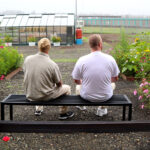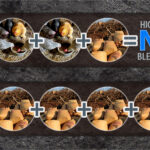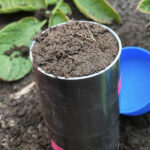
Sally Brown
BioCycle October 2014
The Northwest Biosolids Management Association had its 27th Annual Biofest Conference last month. Biofest is always in a beautiful place, always a great selection of microbrews, always a great group of friends and colleagues, and always a science based presentation or two on emerging contaminants in biosolids. This year the presentation was all about perfluorinated organics and was given by Dr. Chris Higgins from the Colorado School of Mines.
Perfluorinated compounds are a really fascinating group of compounds if you are a chemist. They are characterized by carbon bonded to fluorine — hence the name. Per is a prefix used to mean present throughout so perfluorinated means that the compounds have lots of fluorine in them. They can form acids — perfluoralkyl salts referred to as PFAAs. They can also be present as perfluorooctane sulfonate (PFOS) and perfluorooctanoate (PFOA). They are very useful compounds, being soluble in both oil and water and being able to repel both oil and water. And useful means ubiquitous. Different versions of these compounds are found in nonstick pans, carpets, popcorn bags, different flame retardants, and in Goretex fabrics.
These compounds are tricky (aka interesting) from a chemistry perspective as they are nearly impossible to degrade. They can move through a soil profile and have been detected in all types of environments and animals including polar bears. Here I am talking about polar bears in their natural habitat, not polar bears in zoos with habitat that includes nonstick carpets.
All of this means that they also show up in biosolids. At Biofest, Dr. Higgins did a great job explaining his studies, showing that these compounds can be taken up by plants that are grown in biosolids-amended soils (see Blaine, et al, 2013). He also did his job by expressing concern about the safety of biosolids, noting a potential for these compounds to suppress immune systems. My natural tendency is to get mad at the scientist, get mad that yet again, the safety of the beneficial use of biosolids is being questioned because of parts per billion concentrations of some compound that you can find in every room of your house, at much higher concentrations. After 27 Biofests (I’ve probably only attended 15 or 16 of these) though, I’m starting to realize that getting mad and defensive is not really a productive or mature approach.
Perfluorinated compounds show up in biosolids and in this case many composts because they either have or are perceived to have benefits in the range of home products that end up contributing to biosolids. Take deodorants for example. At a recent workshop on biosolids in Boise, Idaho, I was giving a talk about these microconstituents. A treatment plant operator raised his hand and pointed out that deodorants also contained chemicals that people were worried about, people including his wife.
Finding A Balance
This brings me to this month’s contaminant: nitrosamines. The lessons learned from this month’s contaminant can be applied to the perfluorinated compounds, the deodorant compounds, antibiotics, and all of the other chemicals that we are concerned about. A recent paper measured the concentration of nitrosamies (formed when nitrite or nitrate reacts with amines, a component of certain proteins) in archived biosolids samples (Venkatesan, et al, 2014). These compounds are thought to cause cancer. The authors found them at concentrations of about 500 parts per billion ($5 per $10,000,000, to put that concentration in perspective). And doing their job, they concluded that additional research needed to be done to determine if the presence of these compounds posed a sufficient threat to question the benefits of land application of biosolids.
In reading about nitrosamines, I learned (or was reminded) that they were initially a concern in cured meats. Nitrite was added to meats to preserve them, add color and preserve flavor. Using nitrites was a very effective way to prevent people from getting botulism. When the meats were cooked, here the focus was on bacon, the nitrites formed nitrosamines. Fried bacon was found to have nitrosamines at concentrations up to 100 parts per billion ($1 per $10,000,000). USDA worked with meat producers to reduce the quantity of nitrites added to meats, seeking a sweet spot where botulism was prevented but also the formation of nitrosamines was blocked. Turns out these compounds are also formed when water is treated with chlorine to kill pathogens — again a balance, using a compound to prevent one hazard that may end up resulting in a different hazard. It becomes a balance: How to get the optimum benefits while minimizing the risk.
For certain compounds we are starting to see that the benefits are minimal for most uses. Here I am talking about antimicrobial compounds (triclocarban or TCC and tricolosan or TCS). These compounds are widely used in a range of household products including soaps, shampoos and toothpastes. This widespread use has resulted in widespread detection in people. At the same time, scientists are realizing that the promised benefits of these compounds are not being demonstrated with product use. While the long-term hazards of these are not known, a few states have proactively started banning these compounds. If they are banned, the concentrations in biosolids will decrease. That is what happened with lead and dioxins. That is what should happen.
It is also starting to happen with antibiotics. These compounds are useful — so useful in fact that they are overused. Antibiotics are prescribed about six times more frequently for people in the U.S. than for people in Scandinavia. They are used prophylatically in animals and overused in humans. And yes, they do show up in biosolids. President Obama has just announced plans to reduce use of these compounds as a way to preserve their utility and prevent development of antibiotic resistant strains. Like a ban, restricting use will also result in lower concentrations in the biosolids.
Proper Place For Concern
People who work with biosolids often feel like biosolids are what always get picked on, sort of like the low hanging fruit. That may be the case. But as the saying goes, “you don’t get apples from a pear tree.” These compounds show up in biosolids because they are present, typically at much higher concentrations, further up the tree. These days, that tree is typically someone’s home. If they are a concern in the biosolids, then it is time to question whether they belong in the tree in the first place.
So rather than getting angry at the scientist, feeling picked on, and dismissing public concerns, a better approach might be to work with scientists, the public and public officials to communicate and share these concerns. These compounds show up in our wastes because they are in our homes. Understanding the benefits and associated risks of these compounds is part of this process. Working to maximize the benefits and minimize the risks is a much better option than just getting angry and defensive. That is true for the compounds, and it is true for the biosolids (and composts).
Sally Brown is a Research Associate Professor at the University of Washington in Seattle and a member of BioCycle’s Editorial Board.










